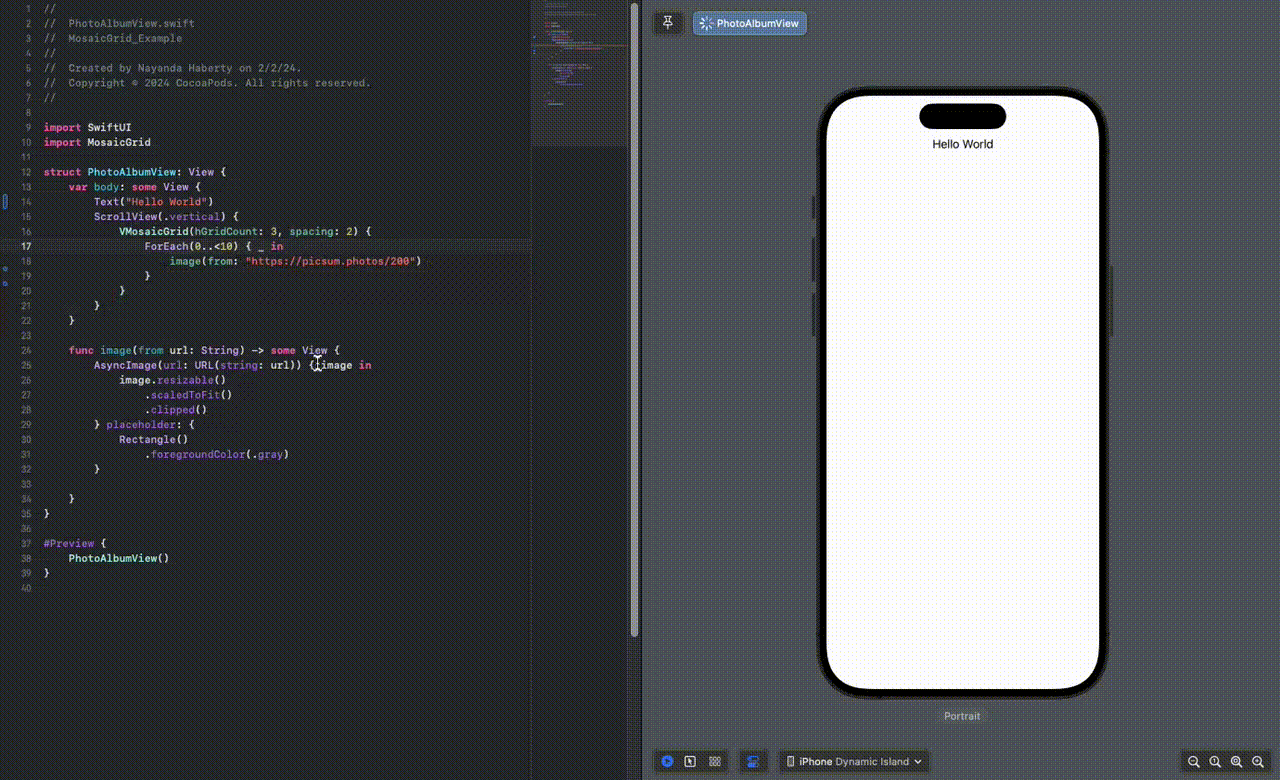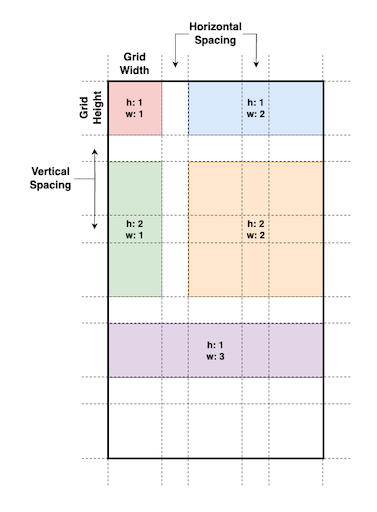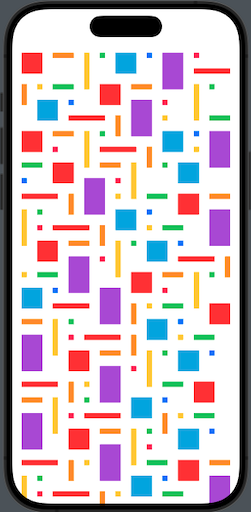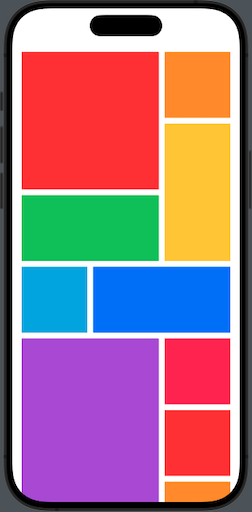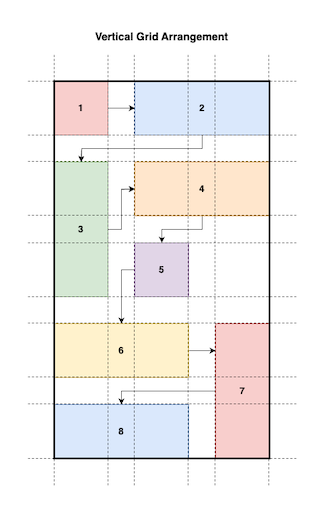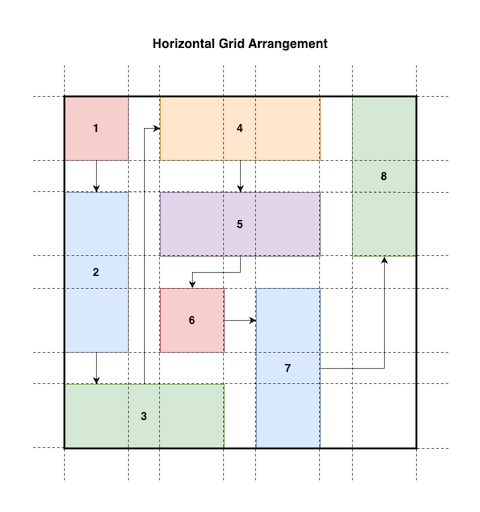MosaicGrid is a SwiftUI library that provides both horizontal and vertical mosaic grid views, along with utility functions for customizing view tile sizes and placement. These components allow you to arrange multiple items in a visually appealing grid layout.
To run the example project, clone the repo, and run pod install from the Example directory first.
- Swift 5.5 or higher
- iOS 16.0 or higher
- MacOS 13.0 or higher
- TVOS 16.0 or higher
- WatchOS 8.0 or higher
- Xcode 14 or higher
You can easily install MosaicGrid via CocoaPods. Add the following line to your Podfile:
pod 'MosaicGrid', '~> 1.1.2'To install using Xcode's Swift Package Manager, follow these steps:
- Go to File > Swift Package > Add Package Dependency
- Enter the URL: https://github.com/hainayanda/MosaicGrid.git
- Choose Up to Next Major for the version rule and set the version to 1.1.2.
- Click "Next" and wait for the package to be fetched.
If you prefer using Package.swift, add MosaicGrid as a dependency in your Package.swift file:
dependencies: [
.package(url: "https://github.com/hainayanda/MosaicGrid.git", .upToNextMajor(from: "1.1.2"))
]Then, include it in your target:
.target(
name: "MyModule",
dependencies: ["MosaicGrid"]
)MosaicGrid is similar to UICollectionView, but with much more flexibility. MosaicGrid will divide the view into grids (with spacing if have any) and allow you to utilize it for view placement.
How the placement will go will depend on the type of MosaicGrid you use, whether is it VMosaicGrid or HMosaicGrid. You can utilize usingGrids(h:v:) to control how many tiles will be used for each view. With this, arranging UI with grid placement will be very easy!
Like this photo album example, or this abstract-like art 😜
VMosaicGrid is a vertical mosaic grid view. It will try to fill the horizontal grids then continue down and make the view grow to the bottom.
VMosaicGrid(hGridCount: 3, spacing: 2) {
ForEach(models) { model in
MyView(from: model)
.usingGrids(h: model.width, v: model.height)
}
}The arrangement will be following this pattern:
You can customize how the grid size is calculated by using these 3 different init:
public init(hGridCount: Int, spacing: MosaicGridSpacing = .zero, gridAspectRatio: Double = 1, @ViewBuilder content: @escaping () -> Content) { ... }public init(hGridCount: Int, spacing: MosaicGridSpacing = .zero, gridHeight: CGFloat, @ViewBuilder content: @escaping () -> Content) { ... }public init(gridSize: CGSize, minimumSpacing: MosaicGridSpacing = .zero, @ViewBuilder content: @escaping () -> Content) { ... }HMosaicGrid is a horizontal mosaic grid view. It will try to fill the vertical grids then continue right and make the view grow to the right.
HMosaicGrid(vGridCount: 3, spacing: 2) {
ForEach(models) { model in
MyView(from: model)
.usingGrids(h: model.width, v: model.height)
}
}The arrangement will be following this pattern:
You can customize how the grid size is calculated by using these 3 different init:
public init(vGridCount: Int, spacing: MosaicGridSpacing = .zero, gridAspectRatio: Double = 1, @ViewBuilder content: @escaping () -> Content) { ... } public init(vGridCount: Int, spacing: MosaicGridSpacing = .zero, gridWidth: CGFloat, @ViewBuilder content: @escaping () -> Content) { ... } public init(gridSize: CGSize, minimumSpacing: MosaicGridSpacing = .zero, @ViewBuilder content: @escaping () -> Content) { ... }SpacerTile is a utility function to create a clear rectangle with a given tile size. It is used if you want to make sure some grids are not occupied with a view.
VMosaicGrid(hGridCount: 3, spacing: 2) {
ForEach(models) { model in
MyView(from: model)
.usingGrids(h: model.width, v: model.height)
// spacer that fills grid 3x1
SpacerTile(h: 3, v: 1)
}
}MosaicGridSpacing is a struct representing horizontal and vertical spacing for Mosaic Grid. It's an object passed when creating MosaicGrid to represent spacing. Normally we can just use Double literal since this struct implements ExpressibleByFloatLiteral and ExpressibleByIntegerLiteral.
// Using Integer literal
VMosaicGrid(hGridCount: 3, spacing: 2) { ... }// Using Double literal
VMosaicGrid(hGridCount: 3, spacing: 2.0) { ... }// Using MosaicGridSpacing. h is horizontal spacing, v is vertical spacing
VMosaicGrid(hGridCount: 3, spacing: .init(h: 2, v: 2)) { ... }Contributions are welcome! Please follow the guidelines in the CONTRIBUTING.md file.
MosaicGrid is available under the MIT license. See the LICENSE file for more info.
This project is maintained by Nayanda Haberty.




